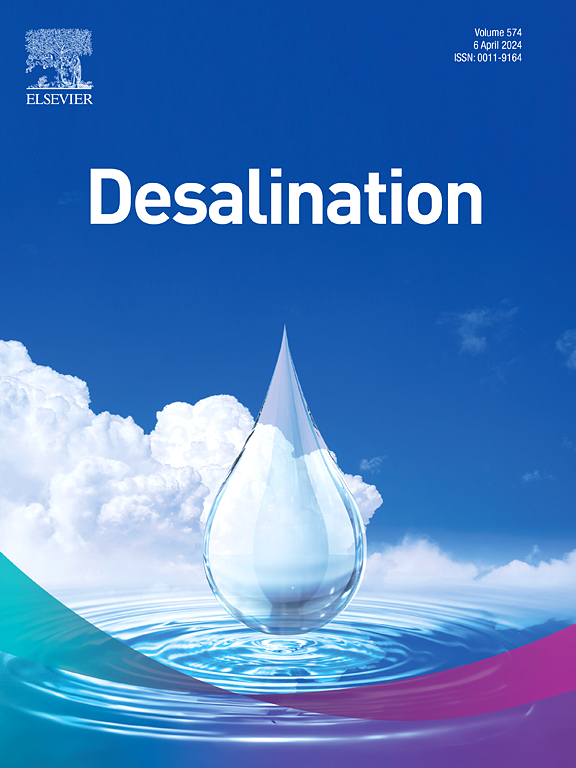结垢与生物污染:SWRO盐水再浓缩直接接触膜蒸馏的挑战
IF 9.8
1区 工程技术
Q1 ENGINEERING, CHEMICAL
引用次数: 0
摘要
膜蒸馏(MD)是一种很有前途的技术,可以将海水反渗透淡化装置中的卤水再浓缩,以达到最小或零液体排放。然而,MD易受结垢和生物污染的影响,但它们在不同海水盐水条件下对膜性能的具体影响尚不清楚。本研究使用定制的MD系统来确定结垢(仅含卤水)和生物污垢(含原生微生物的卤水)对膜性能的影响。通过将给水加热到50°C来蒸馏亚喀巴湾的高盐盐水,会导致盐的少量沉淀和膜表面的稀疏生物膜,对馏分通量和盐的抑制作用最小。然而,仅将给水温度提高8度至58°C,就会显著加速结垢,从而损害膜性能,58小时后馏分液通量降低40%,排盐率降低55%。用从亚喀巴湾收集的微生物接种加热后的盐水,排盐率降低96%,排盐率降低95%。分离能力的关键缺陷是由于光学相干断层扫描捕获的生物膜发展后的膜润湿。与此相对应的是,附着在膜表面的细菌大部分呈现出痛苦状态,并嵌入有机物中,有一部分细菌穿透了孔结构。这种细菌浸润表明存在不可逆污垢的风险,这可能会显著缩短MD的使用寿命。这些研究结果表明,即使是给水温度的轻微升高也会对MD性能产生重大而有害的影响。因此,根据现场特定的环境条件,特别是化学成分和微生物负荷来优化给水温度,对于最小化有害影响和确保SWRO盐水再浓缩MD的长期可持续性至关重要。本文章由计算机程序翻译,如有差异,请以英文原文为准。

Scaling vs. biofouling: Challenges in direct-contact membrane distillation for SWRO brine reconcentration
Membrane distillation (MD) is a promising technology for reconcentrating the brine from seawater reverse osmosis desalination facilities to achieve minimal or zero-liquid discharge. However, MD is susceptible to both scaling and biofouling, yet their specific impacts on membrane performance under different seawater brine conditions remain poorly understood. This study used a custom-made MD system to determine the impacts imposed by scaling (brine only) and biofouling (brine with native microbes) on membrane performance Distilling hypersaline brine from the Gulf of Aqaba by heating the feedwater to 50 °C resulted in minor precipitation of salts and sparse biofilm on the membrane surface with minimal effects to distillate flux and salt rejection. However, increasing the feedwater temperature by only 8 degrees to 58 °C led to significantly accelerated scaling, which impaired membrane performance, reducing distillate flux by 40 % and salt rejection by 55 % after 58 h. Inoculating the heated brine with microbes collected from the Gulf of Aqaba resulted in even faster reduction in salt rejection by 96 % and distillate flux by 95 %. The critical deficiency in the separation capacity was due to membrane wetting following the development of biofilm captured by optical coherence tomography. Correspondingly, most bacteria attached to the membrane surface appeared distressed and were embedded in organic matter, while a fraction was observed penetrating the pore structure. This bacterial infiltration suggests a risk of irreversible fouling, which could significantly shorten MD lifespan. These findings highlight that even a slight increment in feedwater temperature can lead to significant and detrimental impact on MD performance. Therefore, optimizing feedwater temperature based on site-specific environmental conditions, particularly chemical composition and microbial load is critical to minimizing detrimental effects and ensuring the long-term sustainability of MD for SWRO brine reconcentration.
求助全文
通过发布文献求助,成功后即可免费获取论文全文。
去求助
来源期刊

Desalination
工程技术-工程:化工
CiteScore
14.60
自引率
20.20%
发文量
619
审稿时长
41 days
期刊介绍:
Desalination is a scholarly journal that focuses on the field of desalination materials, processes, and associated technologies. It encompasses a wide range of disciplines and aims to publish exceptional papers in this area.
The journal invites submissions that explicitly revolve around water desalting and its applications to various sources such as seawater, groundwater, and wastewater. It particularly encourages research on diverse desalination methods including thermal, membrane, sorption, and hybrid processes.
By providing a platform for innovative studies, Desalination aims to advance the understanding and development of desalination technologies, promoting sustainable solutions for water scarcity challenges.
 求助内容:
求助内容: 应助结果提醒方式:
应助结果提醒方式:


